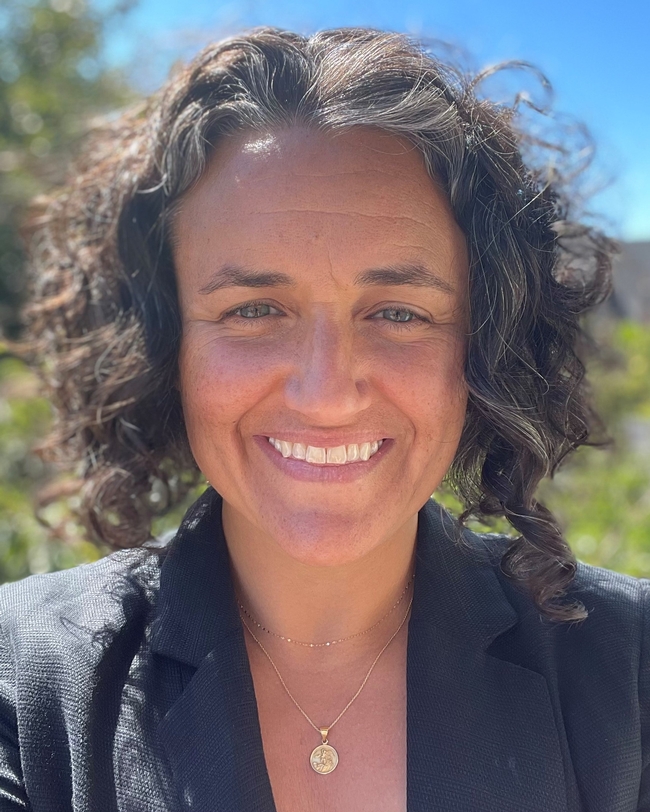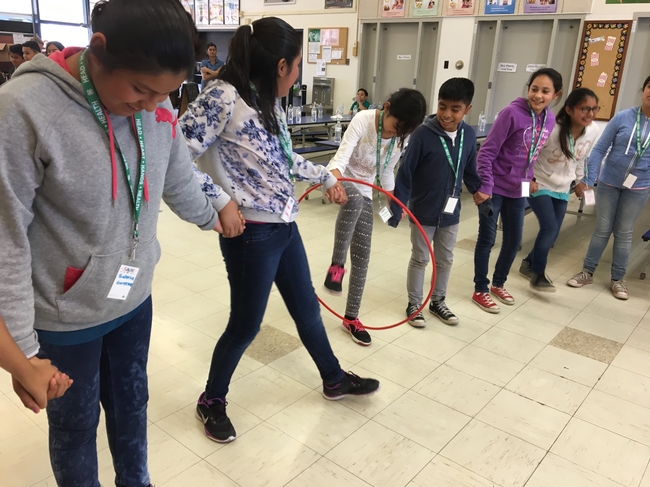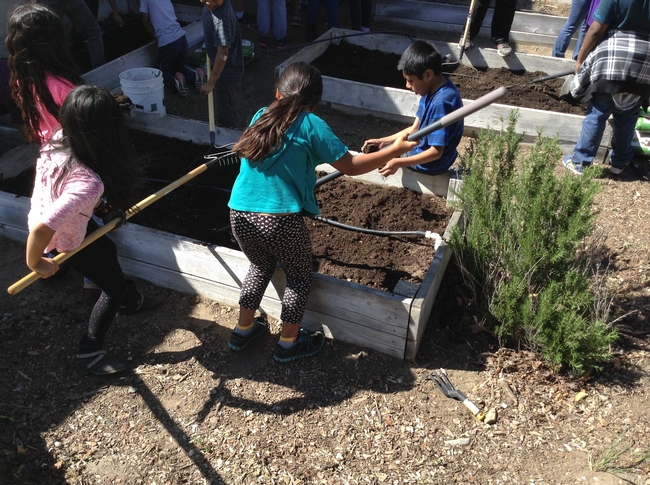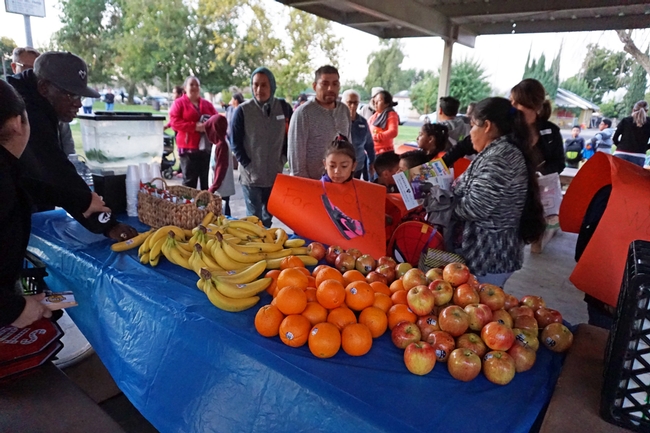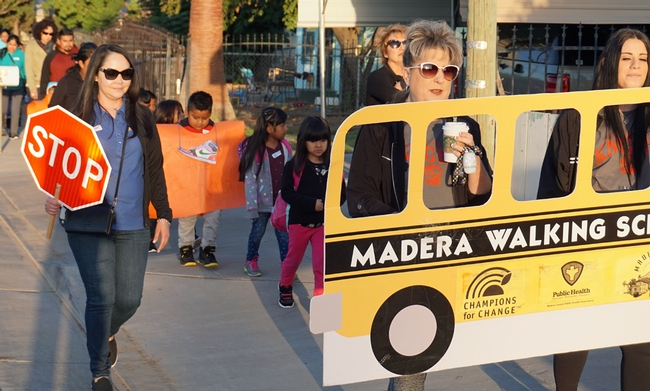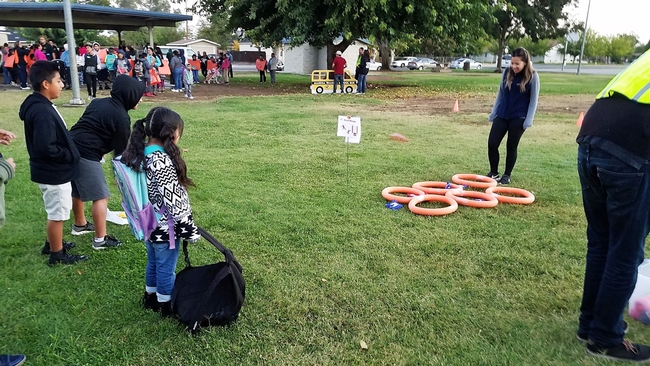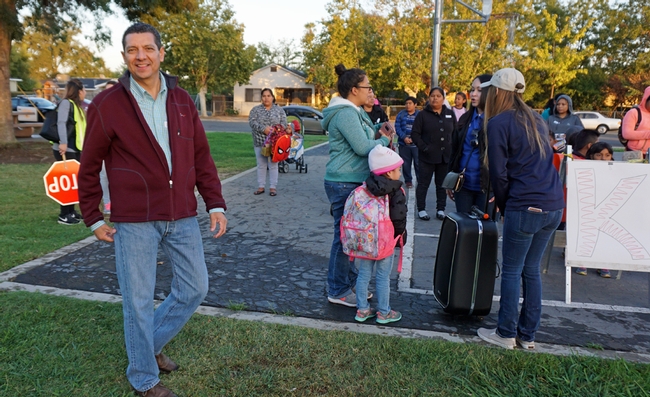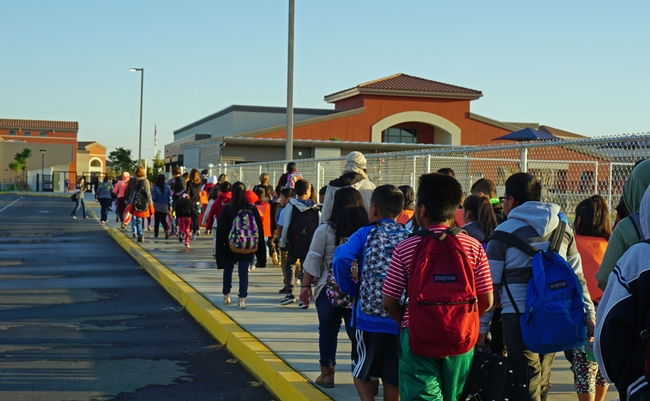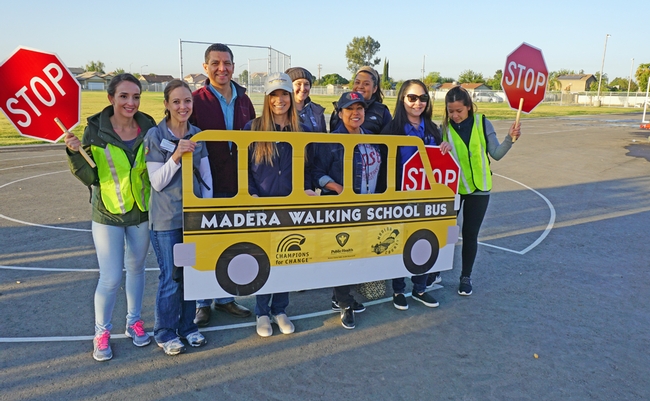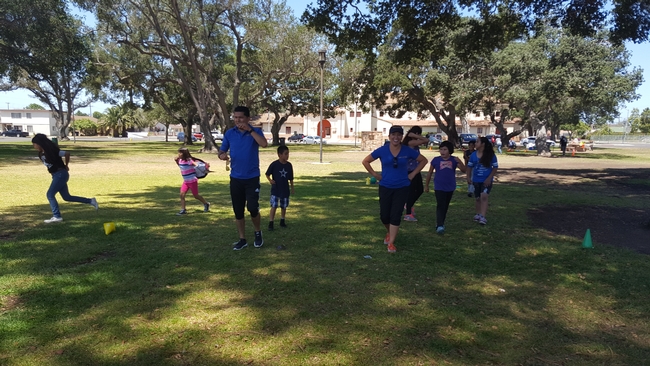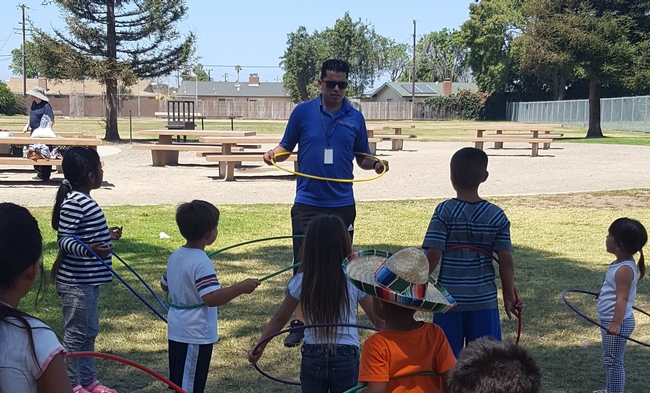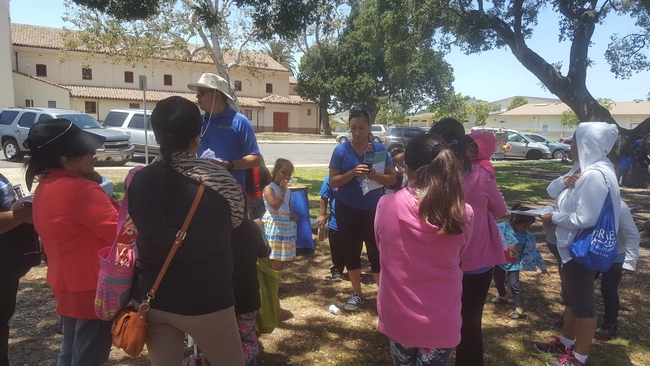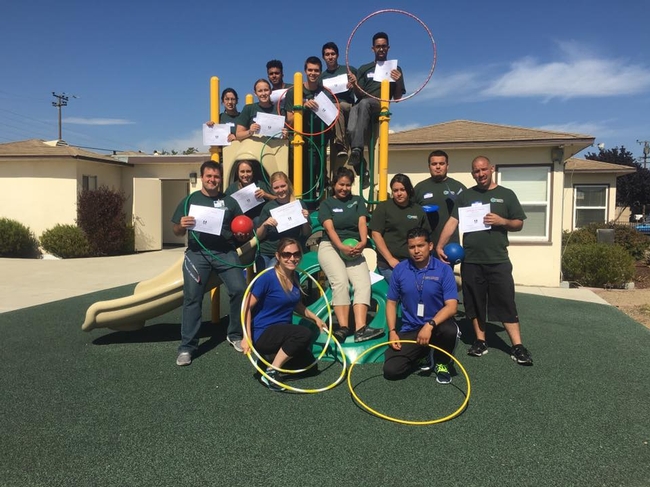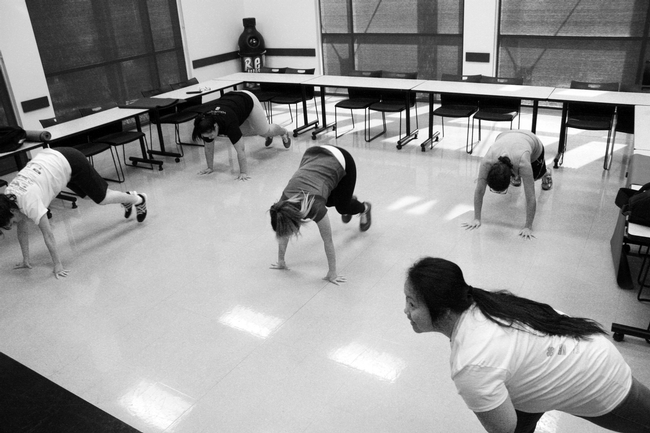Posts Tagged: physical activity
NPI researchers find school recess varies with school size, family income
New law mandates at least 30 minutes of recess for K-8 public school students
Last year, while working on a bill that would require California public schools to provide at least 30 minutes of recess, State Sen. Josh Newman sought the latest research on youth physical activity. Newman, whose district encompasses parts of Los Angeles, Orange and San Bernardino counties, traveled to the Bay Area to see one of the leading experts in the field.
During several visits with Newman, Hannah Thompson – a Nutrition Policy Institute senior epidemiologist and an assistant research professor in the University of California, Berkeley School of Public Health – shared the most recent science.
Both the American Academy of Pediatrics and Centers for Disease Control and Prevention recommend that children have 20 minutes or more of daily recess. But, when asked about the current “state of recess” across California, Thompson said she only knew of anecdotal evidence at the state level.
“I said, ‘You know what? I don't actually know what is going on in California,'” Thompson recalled. “I contacted a couple of colleagues who had done more national-level work on recess that included samples of California schools – but no one was really able to disaggregate what was happening in California.”
She brought up the bill during a meeting with her fellow researchers at NPI, an institute under UC Agriculture and Natural Resources.
And it turned out that Janice Kao, an NPI academic coordinator, had exactly what she needed.
CalFresh Healthy Living evaluation team provides key recess data
Kao leads a project team that evaluates local health departments' programs of CalFresh Healthy Living – California's version of the educational arm of SNAP (the federally supported Supplemental Nutrition Assistance Program).
As part of that evaluation process, Kao's team coordinates questionnaire administration at SNAP-Ed-eligible schools that are partnering with local health departments on CalFresh Healthy Living interventions, ranging from nutrition programs to physical activity initiatives. The survey asks school administrators about their current policies, environments and practices – including the provisioning of recess.
“It was just really good luck that everything was in the right place at the right time to be able to work together,” Thompson said.
At Thompson's request, Kao and her colleagues processed and cleaned that crucial piece of data, comprising responses from 153 low-income elementary schools in the 2021-22 school year.
“Just 56% of schools reported providing more than 20 minutes of recess daily,” Kao said. “So this was a situation where the data showed, ‘OK, there is some room for improvement, perhaps at that state policy level.'”
Thompson and Rebecca London, a sociologist at UC Santa Cruz, wrote a research brief detailing their analysis of the data. They describe disparities in recess time based on school size and income level of families, with students in larger, less affluent schools generally receiving less daily recess.
Thompson said those disparities are related to funding and academic inequities, as the imperative to boost test scores forced schools to increase certain classroom hours at the expense of recess time.
“We did all this work engineering physical activity out of the school day despite the tremendous body of evidence that shows physically active kids not only are healthier but can concentrate better; they have better academic performance, fewer disruptions, better classroom behavior,” explained Thompson, a former physical education teacher in Oakland. “In trying to address that academic gap, we ended up exacerbating a lot of these public health disparities.”
Virtual learning during the pandemic showed educators and parents – firsthand – the harmful effects of children staying sedentary in front of computer screens for hours. But the resulting momentum for restoring recess and time for physical activity was soon stalled as schools tried to make up for “lost time” in returning to classrooms, Thompson said.
NPI resources, expertise invaluable to lawmakers
Newman's bill, SB 291, was an attempt to lock in those recess minutes that are crucial for student health, development and scholastic performance. Both Thompson and London testified before the Senate Education Committee in April 2023, providing the senators with science-based information and context to guide their policymaking.
“Crafting policies rooted in science is critical for legislators to ensure our policies are impactful,” Newman said. “The work of Dr. Thompson and her colleagues at UC provided clear and useful guidance on the benefits of unstructured play and how to improve health and educational outcomes in California schools.”
Gov. Gavin Newsom signed SB 291 into law last October. Starting this coming school year, public elementary and middle schools across California will be required to give at least 30 minutes of recess to K-5 students – and prohibited from withholding recess as punishment.
Kao said her team was excited that their CalFresh Healthy Living evaluation data was useful for lawmakers, illustrating NPI's important role in informing evidence-based policy.
“I'm hopeful that we can use this same data set to also provide key pieces of information on other types of legislation that's in the works, or newly passed legislation,” Kao said.
Thompson said the challenge now will be ensuring schools have the resources and funding to provide quality time for young people.
“If you only have one schoolyard, and it's already dedicated to PE, what do you do now, if you have to increase your time for recess and you don't have that space?” she said.
Thompson added that she is currently applying for a grant to study how schools across California are adjusting to meet the new requirements.
Why I'm the cupcake police
Put yourself for a minute in some kid-sized shoes. Let's call you Maggie. You are in third grade. Your dad works full time and he picked you up from the afterschool program at 6:00 p.m. You and dad got home about 7:00 p.m. because you had to stop by QuikMart to pick up something for dinner and put a little gas in the car. When you got home dad cooked the frozen pizza and you sat down to eat and drink your soda around 7:30 p.m. By the time you finished eating, took your shower, helped dad clean-up and got in bed it was 8:45 p.m.
In the morning you hurry to put your clothes on, brush your hair, brush your teeth and get everything in your school bag for the day. Dad needs to drop you off at school at 7:30 a.m. so he can get to work on time. You grab a bag of chips as you run out the door, rubbing your eyes and looking to make sure you didn't put your shirt on backwards again.
Somewhere around 10:00 a.m. your tummy starts to growl. You feel your mouth start to water a little and your eyes droop. Looking at the clock you count the minutes until lunch. At 11:25 , one of your classmate's parents comes in with a tray of cupcakes to celebrate her birthday! Your stomach jumps at the sight of pink butter cream frosting piled high on the little cakes. Your teacher hands one to each student in the class and you savor every delicious bite.
Fifteen minutes later the lunch bell rings. Your teacher walks everyone over to the cafeteria and you get in line for school lunch. You feel embarrassed to eat school lunch and since you ate that cupcake you're not really hungry anyway. You plop a few things on your plate making a face. Sitting down you pick at the food until the custodian says you can get up and go play. You dump your tray with most of the food still on it and run outside chasing your friends onto the blacktop.
Back in class you feel energized after your game of handball. Your face is red and you're a little sweaty from all the running around. Your teacher announces that your group won the weekly contest and each of you will get to pick from the candy bag. That sounds great to you because you are starting to get hungry again. You put a few pieces of candy in your mouth. You get back to work on your math problem but it's the afternoon and you always have trouble concentrating in the afternoon…
Maggie is just one of more than 30 million children in the U.S. who qualify for free or reduced-price school meals through the USDA school meal program. Students like Maggie may rely on food at school for up to 50 percent of their daily calories and school meals represent a larger portion of the school-day caloric and nutrient intake for food insecure children. In addition, research shows that income level, educational attainment and family composition impact diet quality and physical activity.
The national school lunch program, while not perfect, is intended to ensure students like Maggie are offered a variety of fruits and vegetables and whole-grain rich foods every day. There are limits to the amount of sodium, saturated fat, trans-fat and calories that are offered as part of a school meal. Studies have shown that child nutrition programs improve diet quality and academic performance for children in low-income and food-insecure households.[1]
When we offer our children and students food with little to no nutritional quality for a reward and cupcakes to celebrate a birthday, we are impacting their overall dietary quality for the day. For Maggie, the problem is compounded by the fact that she does not have access to a varied and nutritious diet at home. She has nothing to fall back on when she doesn't get a nutritious meal at school and she fills up on empty calories instead. Childhood is an important time when people develop lifelong eating and physical activity patterns.
So when I am faced with the dilemma, once again, of speaking up and being the cupcake police or staying silent and going along with treats at school, I think of Maggie.
What can you do to create healthier schools for all children:
- Look up your School Wellness Policy. Every school that participates in the School Meal Program has one. However, many times they were written and never revisited. Check your district web page or go to the Dairy Council finder. School Wellness Policies outline what is and is not allowed to be offered in the classroom or fundraisers during school.
- Offer non-food rewards for positive behaviors: Extra physical activity time or recess, the opportunity to eat lunch in the cafeteria with the teacher, special privileges like “line leader” for the day, or the opportunity to go out to the garden. For more healthy reward ideas visit Healthy Food Choices in Schools.
- Celebrations that reinforce health: Include physical activity like a dance party in your celebration (see GoNoodle for all kinds of fun activities and brain breaks), ask parents to bring in a donated book for the class instead of cupcakes (see Books for Birthdays), if you are going to have food, make sure non-nutritious items are limited to one per student.
- Eat lunch with your student(s): If you're a parent, check-in with your school. Many schools allow parents to eat lunch with their children if notified in advance. If you're a teacher, eating with your students is a great way to teach and model healthy eating behaviors. Interested in learning more about the importance of school meals? Find out here.
- Is the school offering a variety of fruits and vegetables? Can the students all see the food and serve it safely? Are any local foods available? If not, set a meeting with the Food Service staff to discuss your ideas and see how you can help.
[1] https://www.ers.usda.gov/webdocs/publications/84003/eib-174_summary.pdf?v=42905
Walk or ride a bike to school to start the day with physical activity
In the pre-dawn chill, UC CalFresh nutrition educators were at McNally Park in Madera Oct. 4 preparing for dozens of kids who were invited to come early for fresh fruit, active outdoor games and the opportunity to walk to school as a group. The event marked International Walk to School Day, part of a year-round movement for walkable communities and safe routes to school.
Walking (or bike-riding) to school provides benefits to the children and the community. Safe pedestrians and bicyclists start the day with physical activity, reduce traffic congestion around schools, and cut pollution.
UC CalFresh educators walked with students heading to Virginia Lee Rose Elementary School, Madera's newest elementary school, which opened this fall. The UC CalFresh Nutrition Education Program, offered by UC Cooperative Extension in Madera County, works in partnership with schools and teachers to provide a comprehensive nutrition education program to students. Since Virginia Lee is new, the walk-to-school event offered an opportunity for UC CalFresh educators to meet students and interact with teachers.
Teaching healthful eating habits is just one of the UC CalFresh goals in local schools.
"We provide a comprehensive approach for healthy schools, focusing on policy, systems and environmental changes as well as teaching healthy eating," said Karina Macias, UC CalFresh manager for Fresno and Madera counties. "Access to a save route to school gives students an opportunity to increase physical activity. It is a component of a healthy lifestyle that we encourage."
Madera's annual Walk to School Day event was organized by UC CalFresh and the Madera County Public Health Department SNAP-Ed Program.
Partnering for a safe and strong summer
School is back in session and students across the nation are busy in the classroom and cafeteria learning and eating. But what happens to students in the summer months when school is out? Research suggests a summer learning achievement gap occurs between children from low income communities and their higher income peers when school is out. Even more, summer has been called “the hungriest time of the year” for low-income children who rely on school meals to get enough food during the school year.
In response to the summer hunger problem, the USDA created the Summer Food Service Program to give schools, agencies, non-profits, etc., the funding to be able to offer free meals to children 18 years and younger at approved low-income sites. Still, as of summer 2015, the summer meal program remained underutilized when compared to the number of low-income children accessing school meals during the regular school year.
To offer excellent programming and increase participation in the summer food program, partnering agencies in Santa Maria worked to provide physical activity, nutrition education and other summer enrichment programming at local city parks in conjunction with the Summer Food Service Program. The Safe and Strong All Summer Long program was coordinated through the Santa Maria City Recreation and Parks to provide free, drop-in recreation opportunities from 11a.m. to 2 p.m. in parks throughout the city all summer. Meals were brought to the parks and served for one hour by the local food bank and Community Action Commission staff and volunteers.
SNAP-Ed funded agencies have been encouraged to partner with Summer Food Service Programs, though the logistics of working with different agencies and providing education programs in non-traditional settings isn't always easy or clear. During summer 2016, UC CalFresh Nutrition Educators in Santa Barbara County partnered with the Safe and Strong All Summer Long food program to provide staff training and support for family enrichment and physical activities. UC CalFresh staff kicked off the partnership by leading a one-day CATCH (Coordinated Approach to Child Health) Physical Activity training for over 20 Recreation & Parks staff. CATCH focuses on inclusive physical education that keeps youth engaged and active. After the training and throughout the summer, UC staff participated weekly at two park summer meal sites encouraging youth and their families to get physically active, drink water and eat healthy. UC staff continued to provide guidance and training on-site to Recreation & Parks staff on how to engage a variety of youth of all ages in fun physical activities.
Several other partner agencies also provided engaging programming to parents while the youth were eating their lunches. The local hospital and County Public Health Department conducted food demonstrations and distributed healthy recipe food samples to parents at sites throughout the city.
In a focus group conducted in June 2016 with parents from the local school district, parents commented that they would like more information and ideas about how and where to do physical activities as a family. Participants commented that they appreciated that their children were learning how to be physically active at school, but it would be helpful to have information on how to involve the whole family: parents, siblings and all of the family so they could get exercise and enjoy their time together.
By providing free drop-in programming at local parks, in conjunction with free meals for youth, the Safe and Strong All Summer Long partnership was able to provide access to safe spaces for families to come together during the summer to be physically active and reduce food insecurity.
UC CalFresh Nutrition Educator Miguel Dia, commented that the best part of the summer partnership was “engaging the youth in a variety of different games and seeing all the different age groups participating. By the end of the summer, the older youth were actually teaching the younger youth how to do the CATCH activities.”
Walking the talk
San Joaquin County nutrition educators are not only promoting physical activity to the families they teach, but walking the talk together every day.
Family nutrition educators from University of California CalFresh [UC CalFresh] and Expanded Food Nutrition Education Program [EFNEP], two federally funded nutrition education programs that provide free nutrition workshops to low-income families, have joined together to practice the lessons they teach to their participants in San Joaquin County, including exercising for at least 30 minutes a day.
“I wanted to exercise more regularly,” UC CalFresh nutrition educator Lorena Hoyos said. “But doing it alone wasn't working, so when the idea of working out as a group came about at training, it was the perfect opportunity. Exercising with others is a great motivator, they keep you active.”
Using home-brought exercise videos like T-25, The Firm, Hip Hop Abs and others, the nutrition staff have been sweating to the beat.
“I noticed that my endurance has gone up,” EFNEP nutrition educator Houa Lee said. “I have more confidence at work and in conducting the physical activity breaks at my classes.”
Prior to the videos, the nutrition staff, along with other San Joaquin County UC Cooperative Extension employees, were doing activities like walking around the block or going to the gym together after work. Some educators even participated in weekend races or rides, such as the Color Run, Hit the Street for Hunger Run, The Electric Run, Cinderella Bike Ride and others.
“I think it's important to show participants that we are not just preaching the goals, but living them,” said Raquel Fernandez, a program representative for the UC CalFresh and EFNEP programs. “This makes them seem a lot more attainable and helps us relate better to our participants. It also helps establish trust and credibility to our lessons.”
Participants have been asking for more physical activity,” EFNEP nutrition educator Monica Radrigan said. “It's the main reason they come and they love it! And as a result, we've noticed retention has been increasing too.”
The exercise sessions have also improved team-building efforts.
“I like to be able to come into workplace where we can support each other,” Community Nutrition Action Plan facilitator Tina Her said. “Not only in a work setting, but on a personal basis as well. This helps me connect with my coworkers better.”
UCCE nutrition, family and consumer sciences advisor Anna Martin said after-work exercise program is a win-win situation.
“I am proud that our staff has initiated activities that not only promote their own physical health, but improves their relationship as a team," Martin said.


